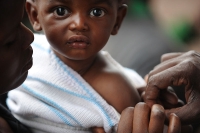IPS Correspondents
JOHANNESBURG, Nov 8 2010 (IPS) – As nearly 25 years of development of a malaria vaccine come to fruition, health authorities across Africa will need to come to grips with how to effectively introduce it.

Malaria accounts for 20 percent of deaths of young children in Africa. Credit: Julien Harnels/Wikicommons
Phase III testing of a malaria vaccine involving up to 16,000 infants in seven African countries has begun; success could see a vaccine ready for use by 2013.
There were more than three-quarters of a million malaria deaths in Africa in 2008, the latest year for which the World Health Organization has compiled data. Most of these were children one in five childhood deaths in Africa is attributed to malaria. For many millions of children who survive, UNICEF says the disease can contribute to anaemia, which hampers growth and development.
A malaria vaccine could radically change this situation. The RTS,S vaccine developed by the Malaria Vaccine Initiative in partnership with GlaxoSmithKline Biologicals will target the most vulnerable: infants aged 6-12 weeks and 5-17 months will be vaccinated, strengthening their resistance to malaria until they reach the age of five.
So far, tests conducted at sites in Burkina Faso, Tanzania and Gabon indicate the vaccine has a better than 50 percent success rate in preventing the disease, according to David Poland, senior communications officer for the non-profit health organisation Program for Appropriate Technology in Health, which runs the Malaria Vaccine Initiative.
Putting it to use
Related IPS Articles
Deploying a new vaccine has to take several factors into account, beginning with a clear idea of the disease burden. The schedule of immunisation has to be considered. Countries introducing new vaccines have to address increased cold chain requirements refrigerated storage for the new medicine, as well as train staff to handle them.
Dr Ahmadu Yakubu, Regional Immunisation Adviser for UNICEF in East and Southern Africa illustrates the challenges with the example of a pneumococcal vaccine introduced in Rwanda in 2009.
When it came out initially, it was in a glass syringe, almost 58 cc per dose, and a child would need three doses of the vaccine, a much larger volume than traditional vaccines that require about 48 cc to fully immunise a child.
This makes a huge difference to the amount of space needed to safely store the vaccine at central, sub-national or district levels.
Fortunately that was changed, the volume was reduced to 4.8 cc per dose, said Yakubu.
Changes like these are made over time by vaccine manufacturers even after introduction, otherwise it puts stress on countries that are already financially constrained. They are trying to use the little money they have to expand on their basic capacity.
Tailored for use in Africa
RTS,S is among a new generation of vaccines intended primarily for use in the South, and its development includes aligning it with the vaccine management needs of the countries it will be used in.
Specifically looking at the malaria vaccine, said Yakubu, there have been interactions with Expanded Programme of Immunisation managers in many countries. Details of each vaccine trial have been made accessible, and their previous experience over time has been looked at, as has the issue of scheduling.
Limited resources mean that concrete steps to expand cold chain capacity, for example, will only be taken once the vaccine is ready to be introduced. But within the limits imposed by available resources, countries are being encouraged to look into the future.
In planning the introduction of new vaccines, said Yakubu, one tries as much as possible to limit the number of visits that a mother needs to make to vaccinate her child. A new vaccine should try as much as possible to fit into existing schedules.
At the Agogo test site in Ghana, principal investigator Tsiri Agbenyega said RTS,S would be best deployed with a number of other vaccines for infants, such as polio and diphtheria.
Agbenyega underlined that the vaccine will only form part of a malaria prevention strategy.
The idea is not for the vaccine to replace other control efforts, Agbenyega said. We want to use the vaccine in conjunction with other measures.